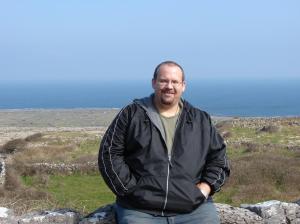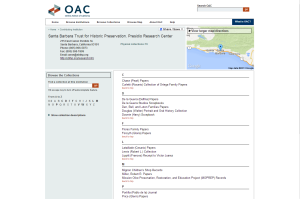By Jennifer Zwigl

Hello! My name is Jennifer Zwigl, and I had the incredible opportunity of interning at the Santa Barbara Trust for Historic Preservation’s (SBTHP)
Presidio Research Center in winter and spring of 2024 as I finished up my English degree at UCSB. Getting to work with Dez Alaniz, Director of the Presidio Research Center, has made the last few months of my undergraduate career far more enjoyable and valuable than I thought possible! My prior research as a journalist at KCSB News helped me tremendously with working on the oral history collections at the Presidio Research Center. At KCSB, I was responsible for writing articles, conducting interviews, editing interviews, and hosting the biweekly newscast live from 5:00-5:30PM at 91.9FM (check it out!). One of the important aspects of KCSB is its status as a nonprofit, community radio station, meaning that I worked to highlight voices and perspectives that large corporate media stations tended to overlook, which I also sought to do during my time at the SBTHP.

As I started work on the oral history collection, I was tasked with organizing, editing, and annotating transcripts of oral histories recorded with community members by various SBTHP volunteers and staff members. During this project, I learned more about the technicalities of archival research and working with oral histories, like how one goes about editing a transcript for easier readability without discrediting someone’s distinctive voice and storytelling style. Simultaneously, I enjoyed getting to listen to the unique, entertaining, tragic, and crucial stories of Presidio culture bearers, like George “Bud”’ Decker, Kathy Chalfant, Cecily Johns, and, of course, local historian Mary Louise Days, who interviewed many of the participants whose transcripts I worked with.

Overall, one of my favorite projects was converting cassette tape interviews into computer audio files that could then be described and made accessible to researchers. This project borrowed heavily from my KCSB skillset, and my familiarity with the Audacity software made this process a lot easier to pick up. Once the cassette was converted, the audio file would be run through Otter.AI, a transcription service, generating a (not necessarily accurate) matching transcript. The transcript I worked most closely with was Kay Kakimoto Willis’ interview with Walt Douglas, which is part of the Walt Douglas Portrait and Oral History Collection. I would then parse back through the transcript, conducting research on specific places, people, and terms the software had failed to identify. After repeating this process multiple times, Dez and I collaborated to produce a set of digitization guidelines, making it easier for other interns, archivists, and researchers to follow a single, consistent workflow. These guidelines included instructions for cassette digitization, rules for transcript editing, a key for making annotations through Otter.ai, and helpful tips for navigating Audacity.

I am incredibly grateful for my time at SBTHP. As an English major, something I heard often is that I will have trouble finding a job after college. As a KCSB member, I had always thought my “career backup” would be news and journalism. However, SBTHP has shown me the many possibilities that exist within Archives, Library Studies, and Museum Studies, and I feel excited and optimistic about exploring these possibilities in the future.







